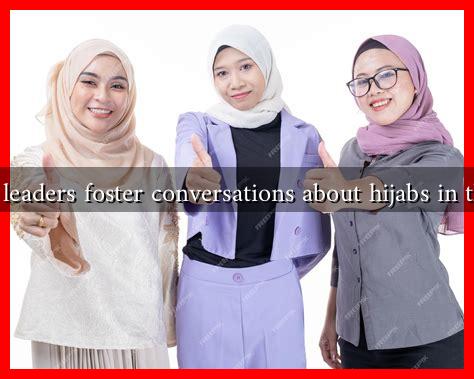-
Table of Contents
How Can Leaders Foster Conversations About Hijabs in the Office?
In today’s diverse workplace, fostering an inclusive environment is essential for employee satisfaction and productivity. One area that often requires sensitive handling is the conversation around hijabs, which are worn by many Muslim women as a sign of faith and identity. Leaders play a crucial role in creating a culture where such discussions can occur openly and respectfully. This article explores effective strategies for leaders to foster conversations about hijabs in the office.
Understanding the Importance of the Hijab
Before initiating conversations about hijabs, it is vital for leaders to understand their significance. The hijab is not merely a piece of clothing; it represents a woman’s personal beliefs, cultural identity, and autonomy. According to a 2017 study by the Pew Research Center, approximately 1.8 billion Muslims live worldwide, with a significant number of women choosing to wear the hijab. Recognizing this diversity is the first step toward fostering meaningful dialogue.
Creating a Safe Space for Dialogue
Leaders must establish an environment where employees feel safe discussing their experiences and beliefs. Here are some strategies to create such a space:
- Encourage Open Communication: Leaders should promote an open-door policy where employees can express their thoughts without fear of judgment.
- Host Informative Workshops: Organizing workshops that educate employees about different cultures and religions can demystify the hijab and promote understanding.
- Implement Diversity Training: Regular diversity and inclusion training can help employees understand the importance of respecting different cultural practices, including the hijab.
Leading by Example
Leaders set the tone for workplace culture. By demonstrating respect and understanding towards employees who wear hijabs, leaders can encourage others to do the same. Here are some ways leaders can lead by example:
- Participate in Cultural Events: Attend events that celebrate diversity, such as Eid celebrations or International Women’s Day, to show support for employees who wear hijabs.
- Share Personal Stories: If appropriate, leaders can share their own experiences with cultural or religious practices, fostering empathy and connection.
- Address Misconceptions: Actively dispel myths and stereotypes about hijabs in team meetings or company communications.
Encouraging Peer-to-Peer Conversations
While leaders play a crucial role, peer-to-peer conversations are equally important. Here are some ways to encourage these discussions:
- Facilitate Group Discussions: Organize small group discussions where employees can share their experiences and learn from one another.
- Establish Employee Resource Groups (ERGs): Create ERGs focused on cultural diversity, allowing employees to connect and share their experiences related to hijabs and other cultural practices.
- Promote Mentorship Programs: Pair employees from different backgrounds to foster understanding and build relationships.
Utilizing External Resources
Leaders can also leverage external resources to enhance their understanding and facilitate conversations about hijabs. Some valuable resources include:
- Islamic Society of North America (ISNA): Offers resources and information about Islamic practices, including the hijab.
- Muslim Women’s Network UK: Provides insights into the experiences of Muslim women, including those who wear hijabs.
- Pew Research Center: Offers data and research on the Muslim population and cultural practices.
Conclusion
Fostering conversations about hijabs in the workplace is essential for creating an inclusive environment. By understanding the significance of the hijab, creating safe spaces for dialogue, leading by example, encouraging peer-to-peer conversations, and utilizing external resources, leaders can promote a culture of respect and understanding. As workplaces continue to diversify, it is crucial for leaders to take proactive steps in addressing cultural practices, ensuring that all employees feel valued and respected. Ultimately, these efforts not only enhance workplace culture but also contribute to overall employee satisfaction and productivity.

